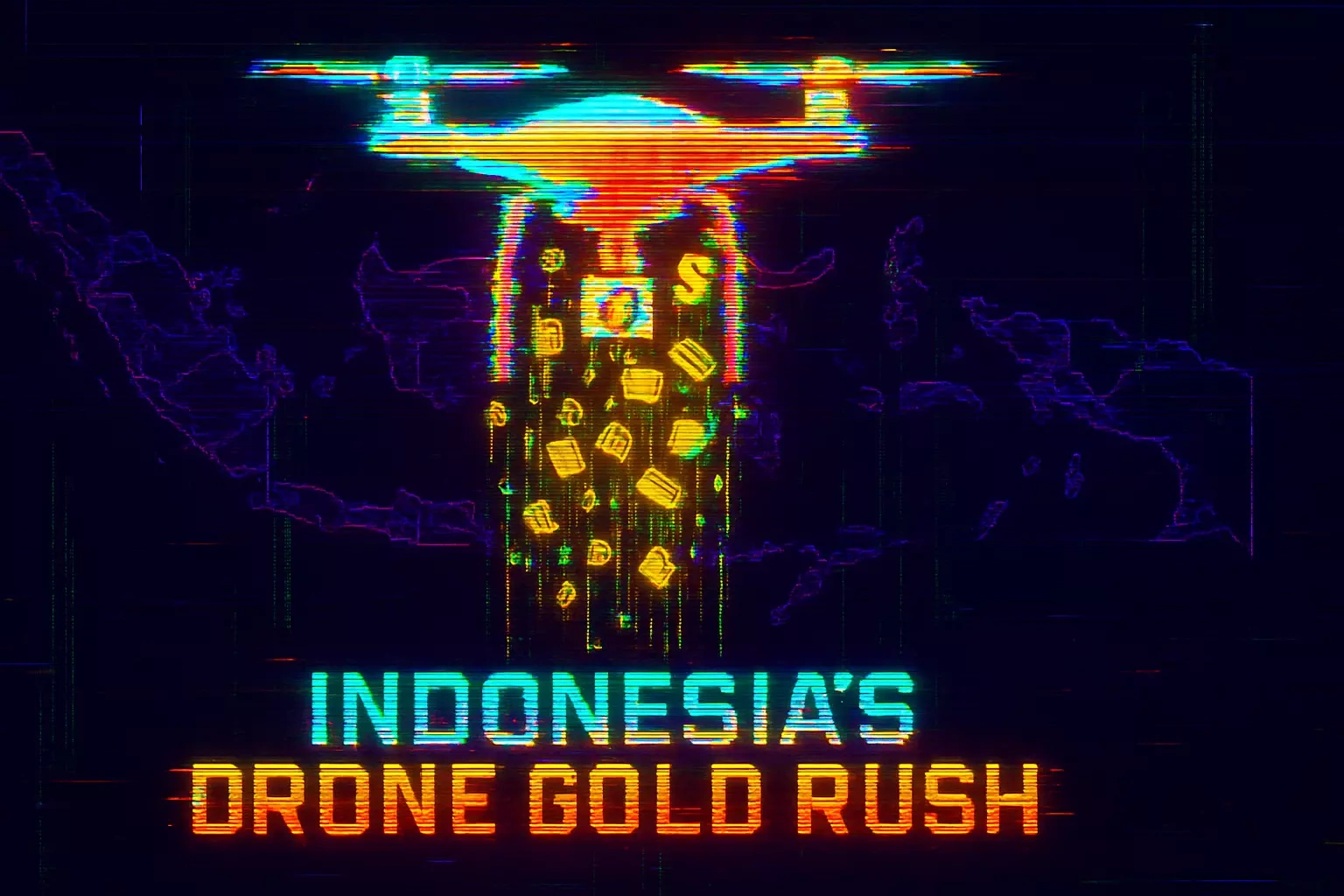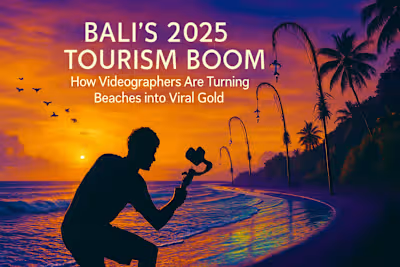Indonesia's Drone Gold Rush: How to Legally Fly and Earn with Aerial Videography

Indonesia's Drone Gold Rush: How to Legally Fly and Earn with Aerial Videography
Flying Legally: Navigating Indonesia's Drone Regulations
Understanding the DGCA Rules
Registration and Certification: The SIDOPI System
The High-Demand Industries for Aerial Videography
Real Estate and Property Development
Tourism and Hospitality
Event Coverage: Weddings, Festivals, and Sports
Gear, Skills, and Pricing: Setting Yourself Up for Success
Choosing the Right Drone and Camera
Mastering Cinematic Drone Shots
How to Price Your Drone Videography Services
References
Indonesia's Drone Gold Rush: How to Legally Fly and Earn with Aerial Videography
Aerial videography adds a breathtaking, cinematic quality to any project, and in Indonesia, the demand for skilled drone pilots is soaring. From capturing the grandeur of destination weddings to showcasing luxury real estate, drone shots are a must-have. The good news is that Indonesia has relatively clear regulations for commercial drone use. This article will guide you through the legal requirements, the best industries to target, and how to turn your piloting skills into profit.
Whether you're an experienced filmmaker or just starting, understanding the landscape of aerial videography is key. The same creative eye that makes freelance wedding filmmakers successful can translate perfectly to drone work. We'll also explore how these skills can be applied to unique niches like underwater videography in Raja Ampat. If you're ready to elevate your career, you can find clients looking to hire drone videographers in Indonesia.
Flying Legally: Navigating Indonesia's Drone Regulations
Before you launch, you need to know the law. Indonesia takes drone safety seriously, and for good reason. With busy airspace and sensitive locations, proper regulation keeps everyone safe while still allowing creative professionals to work.
The regulations might seem complex at first, but they're actually quite straightforward once you understand the basics. Think of it like getting a driver's license – there are rules to learn, tests to pass, and paperwork to file. But once you're through the process, you're free to operate professionally and legally.
Understanding the DGCA Rules
The Directorate General of Civil Aviation (DGCA) oversees all drone operations in Indonesia. They've created a framework that balances safety with practical use. Here's what you need to know.
First, drone weight classes determine what rules apply to you. Most professional camera drones fall into the 2-25 kg category. This sweet spot gives you enough power for quality equipment without entering the more restrictive heavy drone category. If your drone weighs less than 2 kg, some rules are more relaxed, but you'll still need permits for commercial work.
No-fly zones are strictly enforced. You can't fly within 15 kilometers of any airport – that's roughly a 30-minute drive in normal traffic. Military installations, government buildings, and national monuments are also off-limits. Before any shoot, check your location against the official no-fly zone maps. Getting caught in restricted airspace means hefty fines and potentially losing your license.
Altitude restrictions keep drones away from manned aircraft. The standard limit is 150 meters (about 500 feet) above ground level. That's plenty high for most shots – any higher and details start to blur anyway. In certain areas near airports, the limit drops to just 50 meters. Always check local restrictions before flying.
Weather conditions matter too. You can't fly in rain, strong winds over 20 knots, or poor visibility. This isn't just a legal requirement – it's common sense. Water and electronics don't mix, and fighting strong winds drains batteries fast while producing shaky footage.
Registration and Certification: The SIDOPI System
SIDOPI (Sistem Registrasi Drone dan Pilot Drone Indonesia) is your gateway to legal drone operation. This online system handles both pilot certification and drone registration. The process takes about two weeks if you have all your documents ready.
Start by creating an account on the SIDOPI website. You'll need a valid Indonesian ID (KTP) or, for foreigners, a KITAS work permit. Upload a clear photo of yourself and your identification documents. The system is particular about photo quality, so make sure everything is well-lit and in focus.
Next comes the pilot certification process. You'll need to pass an online theory exam covering air law, meteorology, navigation, and drone operations. The test has 40 questions, and you need 75% to pass. Don't worry – the questions are practical, not trick questions. Study the official guide for a week, and you'll be fine.
After passing the theory exam, you'll schedule a practical flight test. An examiner will watch you perform basic maneuvers like takeoff, hovering, figure-8 patterns, and emergency procedures. Practice these moves until they're second nature. The examiner wants to see smooth control and safety awareness, not fancy tricks.
Once certified, you can register your drones. Each drone needs its own registration number, displayed clearly on the body. Upload photos of your drone from multiple angles, along with proof of purchase and insurance documents. Yes, insurance is mandatory for commercial operations – typically around $200 per year for basic coverage.
The whole process costs about 500,000 rupiah ($35) for pilot certification and 250,000 rupiah ($17) per drone registration. Certificates are valid for two years, then you'll need to renew with a simpler refresher process.
The High-Demand Industries for Aerial Videography
Certain sectors are willing to pay top dollar for high-quality drone footage. Understanding these markets helps you focus your marketing efforts and build a profitable business. Each industry has unique needs and expectations, so let's explore the most lucrative opportunities.
Real Estate and Property Development
Luxury villas, hotels, and new developments all need stunning aerial videos to attract buyers and guests. In Indonesia's booming property market, drone footage has become essential, not optional. Developers know that aerial views sell properties faster and often at higher prices.
Start with establishing shots that show the property's location. Buyers want to see proximity to beaches, mountain views, or city skylines. Begin your video with a wide aerial view, then gradually move closer to reveal the property. This creates anticipation and context that ground-level shots can't match.
Focus on unique selling points from above. Does the villa have an infinity pool that seems to merge with the ocean? Show it. Is there a private beach access? Capture the path from property to sand. These aerial perspectives often seal the deal for luxury buyers.
Timing matters enormously in real estate videography. Golden hour – the hour after sunrise or before sunset – transforms ordinary properties into magical retreats. The warm light makes pools sparkle, highlights architectural features, and creates long, dramatic shadows. Plan your shoots around these times, even if it means early mornings.
Work closely with real estate agents to understand their marketing strategy. Some want quick social media clips under 30 seconds. Others need comprehensive 3-minute property tours for their websites. Deliver both from the same shoot to maximize value. Many agents will hire you repeatedly once they see how drone footage accelerates their sales.
Typical rates for real estate drone work range from $300-800 per property, depending on size and video length. Offer package deals for developers with multiple properties. A day rate of $1,500-2,500 works well for larger projects where you're filming several properties in one area.
Tourism and Hospitality
From promoting entire regions to showcasing a single resort, drone videography is essential for the travel industry. Tourism boards, hotels, and tour operators all need compelling aerial content to stand out in a crowded market. Your footage helps travelers imagine themselves in these destinations.
Regional tourism boards often commission comprehensive destination videos. These projects require diverse footage – beaches, temples, rice terraces, cultural events, and local life. Plan multi-day shoots to capture different weather conditions and times of day. A single destination video might pay $5,000-10,000, making these excellent anchor clients.
Hotels and resorts use drone footage across all marketing channels. They need hero shots for websites, dynamic clips for Instagram reels, and longer videos for YouTube. Show the property's relationship to its surroundings. Guests want to see if they're truly beachfront or just "beach nearby." Reveal hiking trails, surf breaks, or cultural sites within reach.
Create storytelling sequences, not just pretty shots. Follow a guest's journey from arrival to departure. Start with their car approaching along a winding coastal road. Show them checking in, then relaxing by the pool. Capture dinner setup on the beach at sunset. End with a sunrise yoga session. This narrative approach engages viewers emotionally.
Tour operators need footage that captures the excitement of their offerings. Film their boats cutting through crystal-clear water. Show hikers reaching a mountain summit. Capture the scale of a waterfall or the mystery of a jungle temple. These action shots sell adventures better than any written description.
Consider creating stock footage libraries of popular destinations. License the same beautiful sunrise over Borobudur to multiple clients. Build a collection of Bali rice terrace footage in different seasons. This passive income stream grows over time as you accumulate more content.
Event Coverage: Weddings, Festivals, and Sports
Drones offer a unique perspective for capturing the scale and energy of live events. This market requires different skills than property or tourism work. You're documenting moments that can't be repeated, so preparation and timing become critical.
Weddings represent a huge opportunity, especially destination weddings in Bali or Lombok. Couples want cinematic moments – the ceremony setup from above, guests arriving at a clifftop venue, or the couple walking on a private beach. These shots add production value that distinguishes professional wedding films from amateur videos.
Safety comes first at events. You're flying over people, so equipment reliability is non-negotiable. Use prop guards, even if they slightly reduce flight time. Maintain higher altitudes when crowds are dense. Have a spotter who watches for hazards while you focus on framing shots. One accident could end your career and hurt someone.
Music festivals and cultural events offer spectacular aerial opportunities. Capture the sea of people moving to music. Show the scale of elaborate stage designs. Film traditional ceremonies from respectful distances. Event organizers often want both live footage for screens and edited videos for future promotion.
Sports events benefit hugely from aerial coverage. Surfing competitions, marathon races, and beach volleyball tournaments all gain drama from drone perspectives. Follow the action dynamically – track a surfer riding a wave or show runners spreading out along a coastal route. This requires practiced flying skills and anticipation of where the action will go.
Coordinate closely with event organizers. Get flight permissions in writing. Understand the schedule so you're airborne for key moments. Some events restrict drone flights to specific times to avoid interfering with the experience. Respect these limits – your reputation matters more than any single shot.
Event rates vary widely. Simple wedding coverage might add $500-1,000 to a videography package. Full festival documentation could command $3,000-5,000 per day. Sports events often pay hourly rates of $200-400, especially if you're providing live feed capabilities.
Gear, Skills, and Pricing: Setting Yourself Up for Success
Having the right equipment and business strategy is just as important as your piloting skills. This section covers the essentials for building a sustainable drone videography business. Smart choices here determine whether you'll thrive or struggle.
Choosing the Right Drone and Camera
A breakdown of the best drones for professional videography starts with understanding that 4K is now the minimum standard. Clients expect crisp, detailed footage that looks good on large screens. Anything less marks you as an amateur. But camera quality is just one factor in choosing your flying platform.
The DJI Mavic 3 Pro has become the go-to drone for many professionals. Its Hasselblad camera delivers stunning image quality with excellent dynamic range. The 43-minute flight time means fewer battery swaps during shoots. The omnidirectional obstacle sensing helps prevent expensive crashes. At around $3,000, it's an investment that pays for itself quickly.
For those starting out, the DJI Air 3 offers remarkable value. You get dual cameras, 46-minute flight time, and 4K/60fps recording for under $1,500. The image quality rivals drones costing twice as much. It's compact enough to hike with but stable enough for professional work.
Don't overlook the importance of ND filters. These "sunglasses for your drone" are essential for achieving cinematic motion blur. Without them, your footage looks unnaturally sharp and jittery. A good set of ND filters (ND4, ND8, ND16, ND32) costs around $150 but dramatically improves your footage quality.
Invest in plenty of batteries – at least four for any serious shoot. Nothing kills momentum like waiting for batteries to charge. Figure $150-200 per intelligent flight battery. Also get a multi-battery charging hub to power up several batteries simultaneously between locations.
A rugged carrying case protects your investment and looks professional. Pelican cases or DJI's official cases work well. Include space for tablets, cables, and accessories. Clients judge professionalism partly by how you handle equipment. Showing up with gear in grocery bags doesn't inspire confidence.
Consider a tablet with a bright screen for monitoring. Phone screens work but become hard to see in bright sunlight. The iPad Mini is popular among drone pilots for its size and brightness. A sunshade hood is essential for tropical conditions – you can't frame shots you can't see.
Mastering Cinematic Drone Shots
Go beyond simple flyovers. Great drone videography tells stories through movement. Master these fundamental shots, then combine them creatively. Practice each move until it's smooth and repeatable. Jerky, uncertain flying screams amateur.
The reveal shot builds anticipation beautifully. Start with your camera tilted down, showing only foreground. As you fly forward, slowly tilt up to reveal the stunning view. This works perfectly for showing properties after flying over jungle or revealing a beach after cresting a hill. Time the reveal for maximum impact.
Orbit shots circle around a subject while keeping it centered. This creates dynamic footage that shows all angles. Vary your altitude during orbits for added interest. Start low and rise while circling, or begin high and descend. Most drones have automatic orbit modes, but manual flying gives you more creative control.
The tracking shot follows moving subjects. This requires anticipating movement and smooth stick control. Practice with cars on empty roads before attempting surfboards or wedding couples. Maintain consistent distance and height for professional results. Diagonal tracking – moving forward and sideways simultaneously – adds energy to scenes.
Pull-away shots create emotional endings. Start close to your subject, then fly backward and upward, revealing the larger environment. This works beautifully for ending wedding films or showing a property's setting. The key is starting very close – fill the frame with your subject before pulling away.
Combine movements for complex shots. Try a low approach that transitions into an orbit. Or start with a tracking shot that becomes a pull-away. These compound movements separate professionals from hobbyists. But remember – sometimes a simple, steady shot tells the story best.
Study films and commercials for inspiration. Notice how Hollywood uses drone shots sparingly for maximum impact. They enhance stories rather than dominating them. Your footage should complement ground-based filming, not replace it. The best drone operators know when not to fly.
How to Price Your Drone Videography Services
Setting your rates requires balancing market demands with your costs and experience. Underpricing hurts everyone – you work for peanuts while dragging down industry standards. Overpricing means sitting at home while competitors get hired. Find your sweet spot through research and experimentation.
Hourly rates work well for simple projects. In Indonesia, professional drone operators charge $100-300 per hour, depending on experience and equipment. This includes flying time, basic editing, and delivery of raw footage. Remember that one hour of flying might require three hours total with setup, travel, and file transfer.
Day rates make sense for bigger projects. A full day (8-10 hours) typically commands $800-2,000. This structure works well for events or multi-location shoots. Clients appreciate knowing their total cost upfront. You avoid the awkwardness of watching the clock during creative work.
Project-based pricing fits best for defined deliverables. A real estate video might cost $500-1,500 depending on property size and final video length. A destination wedding could command $2,000-5,000 for comprehensive coverage. Tourism board projects often reach $10,000+ for multi-day shoots with extensive post-production.
Factor in all your costs when setting prices. Equipment depreciation matters – that $3,000 drone loses value daily. Insurance runs $200-500 annually. Battery replacements cost $150 each after 200-300 cycles. Memory cards, filters, and accessories add up. Travel expenses for remote locations can be substantial.
Post-production time often exceeds flying time. Budget at least two hours of editing for every hour of shooting. Color grading, music selection, and client revisions extend timelines. Some operators charge separately for editing ($50-150/hour), while others include basic editing in their flying rates.
Create packages that make sense for clients. A basic real estate package might include 10 aerial photos and a 60-second video. A premium package adds interior drone footage, twilight shots, and a longer video. Packages simplify client decisions and increase average sales.
Be transparent about additional costs. Rush delivery commands a 50% premium. Flying in challenging conditions (early morning, remote locations) justifies higher rates. Travel beyond 50km typically adds transportation fees. Clients appreciate knowing these policies upfront rather than discovering them in invoices.
Value your expertise appropriately. After investing in equipment, training, and legal compliance, you're providing professional services. Clients hiring drone operators aren't just paying for pretty pictures – they're buying your judgment about safety, weather, and shot selection. Price accordingly.
Indonesia's drone videography market is exploding with opportunity. By following regulations, targeting the right industries, and delivering exceptional footage, you can build a thriving business. The combination of tropical beauty, booming development, and increasing marketing sophistication creates perfect conditions for aerial videographers.
Start with one specialty – perhaps real estate or weddings – then expand as you gain experience and reputation. Build a portfolio that showcases your unique style. Network with other creative professionals who can refer clients. Most importantly, keep flying and improving your skills.
The view from above has never been more valuable. Whether you're revealing hidden waterfalls, showcasing luxury villas, or capturing the joy of celebrations, your drone footage helps clients tell their stories in spectacular ways. Take flight legally, professionally, and creatively – Indonesia's skies are waiting for you.
References
Like this project
Posted Jun 19, 2025
Indonesia's clear drone regulations are a game-changer for videographers. Learn the rules, the best gear, and the top industries paying for stunning aerial shots.







